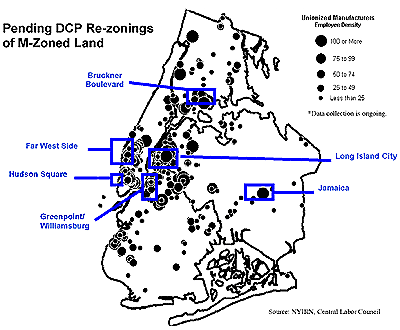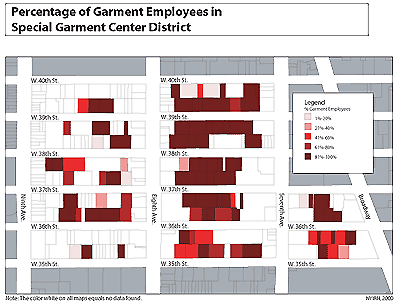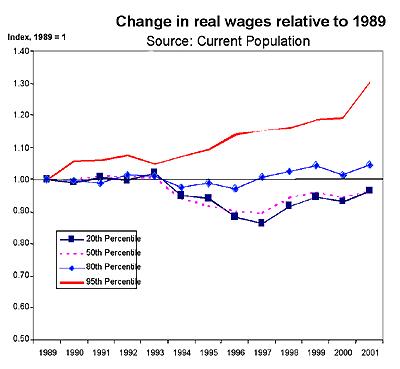The city is putting together a vision of the future that involves making changes to zoning in order to transform many neighborhoods. This includes:
- revitalizing the North Brooklyn waterfront with parks, housing and ferries
- converting Manhattan’s far west side into a mix of new offices and apartment houses, sports and tourist destinations,
- rejuvenating Lower Manhattan as a mixed residential, business and cultural community
- creating a new central business district in Long Island City.

Unfortunately, many of these proposed zoning changes collide with some of the most dense concentrations of manufacturing jobs in New York, risking thousands of jobs and potentially reducing the diversity of the city’s economy.
For example, in Long Island City the number of industrial jobs is actually increasing, but Long Island City is nevertheless the target of rezoning, the second rezoning in two years. This subsequent rezoning will increase real estate speculation that has already pushed rents for industrial space through the roof and risk displacement of thousands of jobs. It also risks the factories that build the stage sets and sew the costumes for our cultural and entertainment sectors, the printers who support our financial services and media, and the food processors who help make New York the culinary capital that attracts tourists and feeds our office workers.
In North Brooklyn, one of the other areas targeted for re-zoning, more than 20 percent of the residents who work have manufacturing or other industrial jobs. This community will be profoundly impacted if these jobs disappear, even if replaced by jobs in other sectors that pay significantly less.
The plans to rezone the Far West Side of Manhattan to create a mix of offices, residences, a stadium and expanded convention center will impact dramatically on the Garment Center, portions of which are within or border the rezoning study area. The Garment Center is home to more then 39,000 apparel jobs. These apparel jobs, many of which are in design and marketing, anchor an industry that employs 110,000 people and that is spread city-wide.

The potential for displacement does not necessarily mean that the city should stop its zoning initiatives. The city needs to rezone some areas. However, at the same time that it encourages new development it also needs to put in place new zoning and economic development tools to minimize the risk of real estate speculation and the loss of jobs.
Whatever the conventional wisdom of a few years ago, the truth is, New York City needs its manufacturers. There is a growing disparity in income between the richest New Yorkers and the rest of the city’s population, and this is due in some great measure to an economy increasingly dependent on a narrow range of industries. These industries pay their most highly skilled workers very well but they produce relatively small numbers of decent middle- and moderate-income jobs. The loss of manufacturing jobs and the drop in unionization are part of this trend.
The average annual production wage is $28,250 -- $10,000 more than average wages in retailing, the sector that is often pointed to as an alternative source of employment. Manufacturing jobs are also more likely to offer health coverage and to be accessible to people who would have difficulty finding decent jobs in other sectors. For example, almost two thirds of the manufacturing workforce is immigrant.

The well-being of many local economies depends on a healthy manufacturing sector. Manufacturing is viable in New York City. Seven of the ten largest cities in the United States experienced an increase in manufacturing jobs during the 1990s. Inc. Magazine, in collaboration with the Initiative for a Competitive Inner City, recently listed its one hundred fastest growing inner city companies and almost one third were manufacturers.
New York City manufacturers have adapted to New York’s demanding environment. Most are small, entrepreneurial businesses that take advantage of New York’s incredible density, creating competitive advantages for businesses that need to be close to their markets, suppliers, design talent and skilled workers. They can even thrive in multi-storied, multi-tenanted buildings, which may be obsolete for the type of manufacturing more characteristic outside the city, because these dense buildings place the manufacturers at the center of their markets.
At present, New York City does not have the land use tools to promote diversity. One might think that having the least restrictive zoning which permits the greatest variety of uses would foster diversity. It is more likely, however, that it will lead to homogeneity as every property owner seeks the greatest economic return on his own property. For example, in an MX Zone, the type of zoning which is increasingly being used by the city, both housing and manufacturing are permitted without restriction, and over time housing will price out manufacturing. The manufacturing that gives the area its character, acts as a buffer against gentrification and gives employment to local residents, will be lost. Diversity, both of physical form, economic activity and even demographic group, may suffer.
The city needs to create new types of zoning that promote diversity. One new zoning tool should be stable mixed residential-manufacturing zoning. In such areas both uses might be legal and manufacturing could be converted to housing, but a critical mass of manufacturing might be preserved through a dedication mechanism. A possible model is the Garment Center, where someone who converts manufacturing space to other uses must dedicate an equal amount of space for manufacturing. This zoning has helped to preserve more then 8,000 production jobs in Midtown Manhattan.
The city also needs to create a new type of manufacturing district. In some sense, New York City doesn’t really have manufacturing zones. It has zones where many uses can locate, including manufacturing, waste transfer stations, pornography, homeless shelters and offices. The city has even tried to put superstores in manufacturing zones. In many instances, the result of this free-for-all is speculation that undermines business investment.
Planned manufacturing districts (or PMDs) would be limited to industrial uses, their ancillary office uses and the neighborhood retailing that supports a manufacturing area. Such districts promote growth by providing the stability that companies need to make investments. Having planned manufacturing districts would also allow the Department of City Planning to target new development to certain areas without setting off speculation in adjacent areas. These manufacturing districts do not prevent change or preserve companies that are no longer viable businesses. Within such a district competition continues between permitted uses. One area in downtown Chicago has experienced a five-fold increase in the number of jobs since it was designated as a planned manufacturing district.
When the city rezones an area or allows the conversion of manufacturing space to other uses, the value of the property can increase dramatically. The city should recapture a small portion of this windfall through a fee or special assessment that can be used to help stabilize businesses in the adjoining areas and help companies that are displaced. This can be done on a building by building basis, as was the case under the Industrial Retention and Relocation Program run by the Business Relocation Assistance Corporation, or it can be done on a district basis similar to an assessment for a business improvement district.
Finally, the city must build the capacity of not-for-profit organizations to engage in the development of industrial space. Such ownership can insulate tenants from real estate pressures to convert manufacturing space. Rents still increase in response to increases in costs, but not speculation.
The city has already begun to recognize the need to promote a more diverse economy. Manufacturing provides better quality jobs for less skilled workers than other sectors which have already gained greater public attention. Supportive land use policies are absolutely essential to achieve a more healthy economic mix that includes manufacturing.
Adam Friedman is the executive director of the New York Industrial Retention Network




